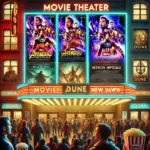Cinema is often described as a visual medium, where stories unfold not only through dialogue but also through the power of imagery. Visual storytelling in film allows filmmakers to evoke emotions, establish settings, and communicate complex ideas without a single word spoken. This approach has been at the heart of filmmaking since its inception, with directors leveraging visual cues to create rich, engaging experiences for audiences.
In this article, we will explore the key elements that contribute to the power of visual storytelling in film and how these techniques shape our cinematic experiences.
The Power of Imagery
Visual storytelling relies heavily on the impact of imagery. Filmmakers carefully design each frame to tell a story, using elements such as color, composition, and lighting to set the tone and mood. For instance:
- Color palettes can signify emotions. Warm colors like red and orange often evoke passion or danger, while cooler tones such as blue and green may represent calmness or melancholy.
- Framing and composition are essential tools. A wide shot can capture isolation, while a close-up can reveal intimate emotions.
- Lighting plays a crucial role in visual storytelling. High contrast between light and dark can create tension or drama, while soft lighting can emphasize romantic or dreamlike sequences.
These elements, when used effectively, create emotional responses in viewers, helping to immerse them into the narrative world.
Show, Don’t Tell: The Essence of Cinematic Language
The phrase “show, don’t tell” is central to visual storytelling in film. Rather than relying on expository dialogue, filmmakers often use visual cues to reveal important plot points or character development. This technique allows for more subtle and nuanced storytelling. For example:
- Body language and facial expressions convey character emotions and intentions without words. A fleeting glance or a nervous twitch can reveal more about a character than a lengthy conversation.
- Symbolism and motifs provide deeper layers of meaning. Repeated symbols, like a bird in flight or a recurring color, can represent themes of freedom, loss, or transformation throughout a film.
These visual hints engage audiences by inviting them to interpret and connect with the story on a more subconscious level.
The Role of Cinematography
Cinematography is a key aspect of visual storytelling, shaping the way a story is presented to the audience. Through the careful use of camera angles, movements, and lens choices, cinematographers guide viewers’ attention and manipulate their emotions. Consider these techniques:
- Camera angles—Low-angle shots can make a character seem powerful, while high-angle shots can make them appear vulnerable.
- Camera movement—A steady, slow-moving camera can create a sense of calm or contemplation, while quick, jittery movements can heighten tension or excitement.
- Lens choice—Wide-angle lenses can capture expansive settings, immersing the viewer in the world of the film, while close-up lenses can emphasize the intimacy of a moment.
These decisions significantly affect the narrative and emotional tone of a film, making cinematography a vital part of visual storytelling.
Production Design and Costume: Setting the Scene
Production design and costumes are essential components that support visual storytelling by establishing the world in which the story takes place. The visual environment—the settings, props, and costumes—can provide a wealth of information about the time period, social status, and even the psychological state of characters. Some examples include:
- Set design can reflect a character’s inner world. A cluttered, chaotic room might suggest mental turmoil, while a minimalist, clean space could indicate control or emptiness.
- Costume design can reflect character development and identity. The choice of fabrics, colors, and styles all contribute to telling a visual story about who the character is and how they evolve throughout the narrative.
These visual choices enrich the story, giving audiences clues that deepen their understanding of the characters and the film’s thematic elements.
Editing: The Rhythm of Visual Storytelling
Editing is another key tool in visual storytelling, as it determines how the story unfolds in time. The pace of cuts, transitions, and the juxtaposition of images all shape the narrative flow. Editors can control the intensity of a scene through:
- Pacing—Quick cuts can create urgency or anxiety, while slower cuts allow the viewer to soak in the emotional depth of a moment.
- Montage sequences can condense time, showing the passage of days, months, or years in just a few moments, creating a visual narrative of progress or transformation.
The rhythm of editing plays a crucial role in guiding the emotional experience of the viewer, making it an essential part of visual storytelling.
Visual storytelling is the heart of what makes film such a powerful medium. Through imagery, cinematography, production design, and editing, filmmakers craft emotional, engaging experiences that transcend dialogue and words. The ability to tell a story through visuals allows audiences to connect with characters, themes, and emotions in profound ways.
In an era where audiences are increasingly drawn to visually rich content, understanding the nuances of visual storytelling is essential for filmmakers and cinephiles alike. The next time you watch a film, pay attention to how much of the story is told through visuals alone—you’ll discover that sometimes, the most powerful stories are the ones that are never spoken.


